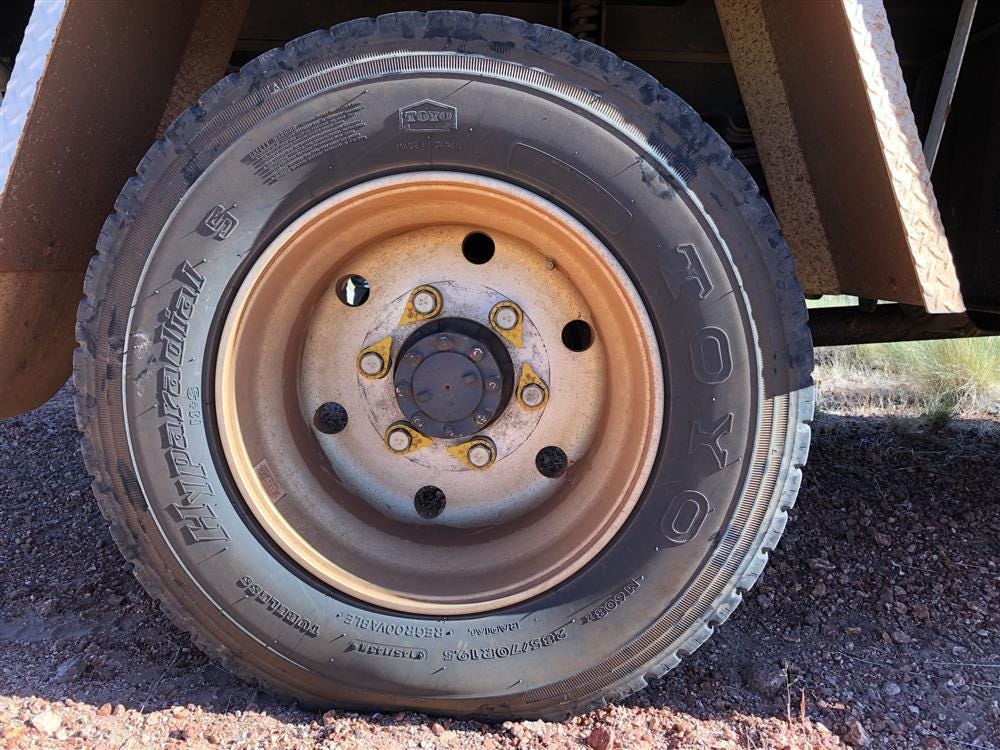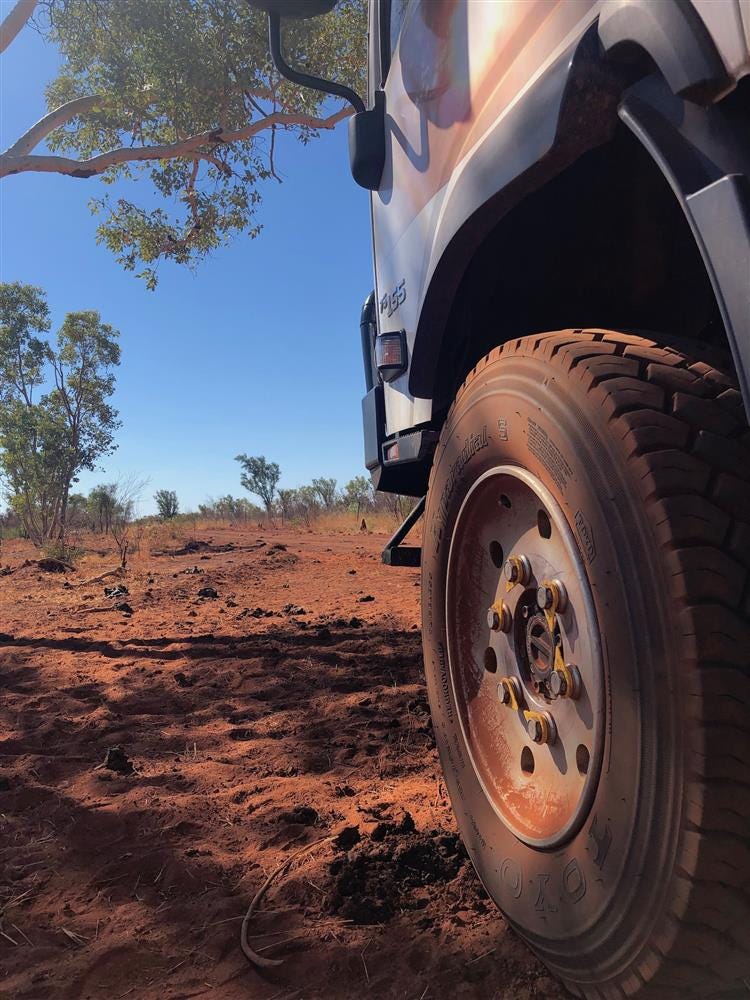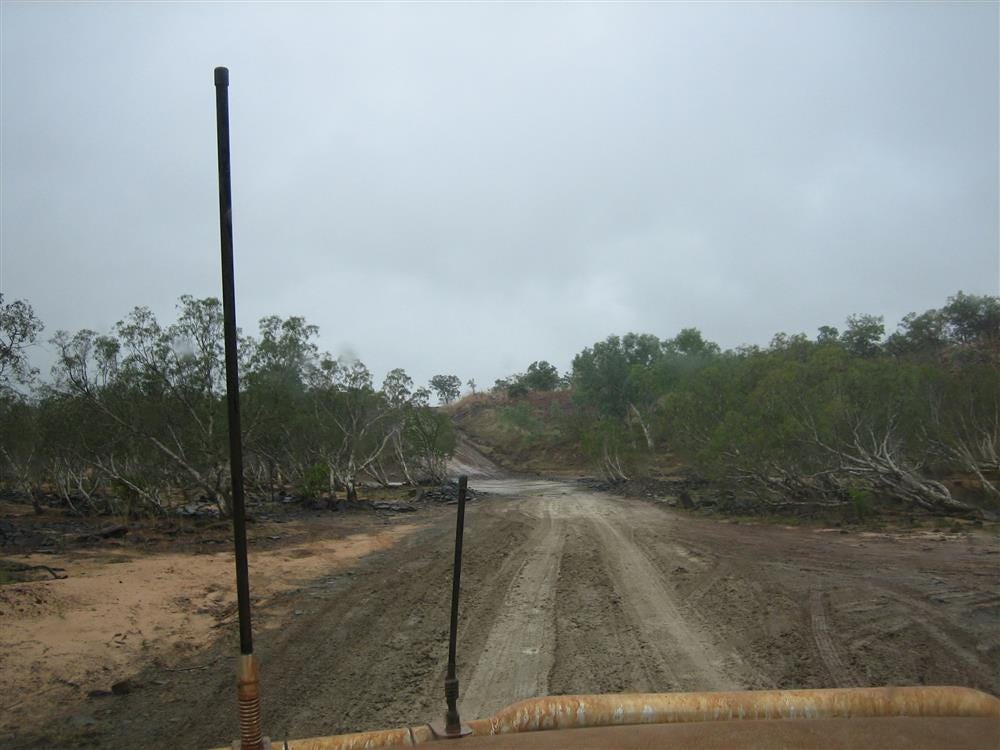Andrew and Peta Murray from Top Wire Traveller travel all over Australia in their truck camper. They travel over all types of terrain, from smooth freeways to the roughest desert tracks. Here they share what they’ve learnt from many years of off-road driving.
Tyre Pressure Basics – Why and when to deflate your tyres
Tyre pressures are a never-ending source of debate and opinion. Some people deflate their tyres to suit every different road surface and condition, while others refuse to adjust their tyre pressures… ever!
We’re somewhere in between. Generally we run just two sets of tyre pressures, one for on-road (tar) and another for off-road (not tar!).
And we air down further only if the situation calls for it.


So, what’s a good guide? And why do you even need to deflate your tyres? We’ll answer the second question first, then we’ll give you a tyre pressure guide for varying situations.
Why you should deflate your tyres off-road
Imagine a fully inflated balloon. You touch it with a toothpick, and it pops instantly. Now try popping a partially inflated balloon with a toothpick. It’s actually quite difficult!
The same basic principles apply to your 4WD tyres.
Say you’re punting down the Tanami Track, with your tyres inflated to road pressure. You drive over a sharp mulga stick. Chances are, it will spear straight through your tyre.
If you’d have let some air out of the tyres, they might have been pliable enough to flex over the mulga stick. Just like the partially inflated balloon and toothpick we talked about earlier.
Flat tyre or blowout averted!
And this is why you need to deflate your tyres off-road. Less pressure allows the tyres to flex more.
Not only this, you’ll get a better ride over rough surfaces like corrugations and rocks. In turn, you won’t be shaking your vehicle to pieces as much.
The other thing worth mentioning here is road speed.
We never travel over 80km/h on dirt roads. One reason is because you never know what ugly washouts or holes are around the corner.
The second reason is tyre damage. Imagine firing an arrow from a crossbow at your tyre. By the way, we don’t recommend this! The arrow will go straight through it. Now try throwing the arrow at the tyre. It’ll simply bounce off.
Now imagine firing a sharp stone at your tyre out of a gun, at 100 or even 120km/h. Chances are it’ll pierce the tyre. Will it pierce the tyre at 80km/h? Maybe, maybe not.
But at least there’s a better chance it won’t pierce the tyre at the lower speed.
If you then combine both lower tyre pressures and lower speeds, you significantly reduce the likelihood of getting a flat tyre or blowout.


An invaluable resource
Since we’re talking tyre pressures, there’s a secret resource available that most people don’t know about.
Contact the manufacturer of your tyre and ask them what pressures they recommend. They’re the experts about your brand of tyre. Most are more than happy for you to contact them… after all, blown tyres are bad for business!
We did this with the Toyo tyres on our truck. They were really helpful.
They should ask you two questions:
1. What size and model tyre do you have? The size is written on the tyre and will be something like 285/70R/17. The model will likely be A/T (all-terrain) or M/T (mud terrain). Or it could be a name imprinted on the tyre. For example, our truck tyres are Toyo Hyparadial.
2. What’s the weight on your front tyres and rear tyres? This is easy to find out. Take your vehicle to your nearest weigh bridge and ask them to weigh it. Easy! Go here for a full list of public weigh bridges in Australia.
How do you get in touch with your tyre manufacturer? The easiest way is to find them on Facebook, then send a Messenger message. The other way is through their Contact Us page on their website.
Ask your tyre manufacturer for a set of pressures for on road and off-road driving.
Now, let’s look at some broad guidelines you can follow for your 4WD.
A guide to correct tyre pressures
These are a broad guide only and depend somewhat on how much weight your vehicle’s carrying, tyre size and type. As we said earlier, contact your tyre manufacturer for the best information.
Having said that, here’s a few guidelines you can follow. These are based on a 4WD loaded for a trip away.
The 5psi rule
Tyre pressures are always quoted as “cold” pressures. The tyre heats up as you drive, and pressure increases as the air inside the tyre heats up.
An excellent guide to whether you’re running the right pressures is the “5psi rule”. Note this really only applies to on-road or smooth gravel roads.
Check your tyres when they’re cold and again when they’re hot (after driving on them for ½ hour or so). If the difference between cold and hot tyre pressures is around 5psi, then you’re running the right pressures.
If it’s less than 5psi, the pressures are probably too high. If more than 5psi then your pressures are too low. Add or remove 5psi at a time and check again. Repeat until the difference between hot and cold pressures is around 5psi.
Now, here’s a few starting points for some of the conditions you might encounter in your 4WD.
Starting points for different conditions
Most of the time, you’ll only need to use the “On Road” and “Off Road (High Range)” pressures listed here. Keep the others in mind for when you get stuck in a nasty situation.
On Road:
- Tar or smooth gravel.
- 38 – 42psi.
Off Road (High Range):
- Rough, stony or corrugated dirt.
- Driving in High Range.
- 28 – 30psi.
Off Road (Low Range):
- Mountainous fire trails or really rough tracks.
- Driving in Low Range.
- 20 – 28psi.
Sand:
- Depends on how soft the sand is.
- Start at around 25psi and reduce by 5psi at a time until your vehicle stops digging in.
- You can go down as far as 15psi or even 10psi if you’re badly stuck. But be really careful. At these low pressures you can easily roll the tyre off the rim. Re-inflate as soon as you can.
Mud:
- Depends on how thick the mud is.
- If it’s thin and watery, leave your tyres at 28 – 30psi.
- If it’s really thick and sticky, you might have to go as low as 18 – 20psi.


In summary
Knowing what pressures to run your tyres on and off-road should be simple… one pressure on-road and another for off-road. Unfortunately there’s plenty of misinformation floating about, both online and in the real world.
Keep it simple. Slow down on gravel and deflate your tyres once off the tar. And enjoy your off-road adventure!
You can follow Andrew and Peta’s outback travel adventures via their website and on Facebook, Twitter, Pinterest and YouTube.
